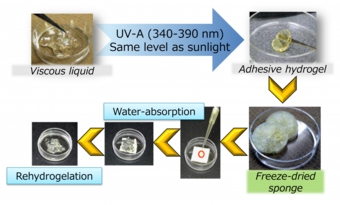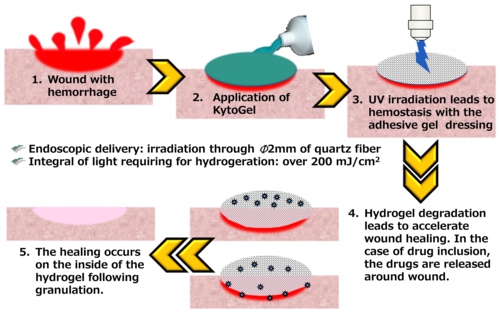Photo-closslinkable chitosan: KytoGEL
The clinical demands on KytoGEL
"Wound care based on physical adhesion"
- Ordinary blood products include the coagulant factors of mammalian protein origin. Therefore these are difficult to use to the patients involving vascular disorder or taking anti-blood coagulants.
“Development goal for NeTech”
- is to supply bio-degradable wound dressing that is physically adhesive and can be used in all sorts of situations.
| Applicable materials for wound dressing |
||
| Mammalian proteins |
Chemicals |
Carbohydrates |
|
Fibrinogen
|
Cyanoacrylate | Starch |
|
Fibrin
|
Polyethylene glycol
|
Cellulose |
| Thrombin | Polyurethane |
Gum Arabic
|
| Collagen | Superabsorbent polymer |
Sodium Alginate
|
| Gelatin | chitosan | |
| Albumin | ||
| Negative factors |
||
| Viral infection | Low degradability |
Low adhesiveness |
| High cost | Toxicity | Purification |
| Low elasticity | ||
Characteristic of the chitosan
| Advantages |
Biodegradable |
|
Biocompatible |
|
|
Antibacterial |
|
| Weaknesses |
Aqueous chitosan: strong acidity |
|
Difficulty for endotoxin removal |
KytoGEL which does not involve chitosan’s weaknesses is a photoreactive polysaccharide.
 Diminished endotoxin (reverse osmosis water level)
Diminished endotoxin (reverse osmosis water level) Neutral liquid (pH 6~7)
Neutral liquid (pH 6~7) Hydrogelation and adhesion arising from irradiating ultraviolet-A
Hydrogelation and adhesion arising from irradiating ultraviolet-A

 We can supply KytoGEL liquid having stabilities of medicine level.
We can supply KytoGEL liquid having stabilities of medicine level.
The operation of KytoGEL

| Bulk powder | Shrimp Chitosan (deacetylation: over 90 %) |
| White powder of KyteGEL does not smell or gives an slight alcohol smell. | |
| The powder of KytoGEL is difficult to dissolve in water and hardly dissolves in ethanol. |
|
| The powder absorbs water, swells up, and then becomes viscous liquid. |
|
| Physical properties | KytoGEL liquid converts itself into hydrogel through irradiating UV-A within 390 nm. |
| KytoGEL covalently reacts to injured tissue, thereby its hydrogel strongly adheres than fibrin glue. (Journal of Biomedical Materials Research Volume 49(2), 289–295, 2000) |
|
| Hydrogel made by KytoGEL is viscous than fibrin glue. |
|
| Autoclavable |
|
|
Stable at room temperature for over one year |
| Antibacterial |
Growth inhibition assay to Escherichia coli, staphylococcus aureus, Pseudomonas aeruginosa, hay bacillus and Klebsiella pneumoniae indicates the property of antibacterial that is equal to versatile methyl paraben. |
| Antivirus function develops through the addition of silver-based antibacterial. | |
| Safety data |
Endotoxin: Less than 0.2 EU/mg powder* (ordinary use: 1~2 wt% liquid)
|
|
Cytotoxicity: negative*
|
|
|
Reverse mutation: negative*
|
|
|
No serological abnormality (rats)
|
|
|
*Entrusted to Hadano research center institute, food and drug safety center |
|
| Formulation | NeTech supplies the raw materials which guaranteed viscosity, photo-reactivity, pH, and stability. |
| Animal studies | KytoGEL is degradable within a month into subcutaneous tissue (mouse/rat) and submucosa (pig). |
| The validity as hemostat, tissue adhesive, wound healing, topical DDS and the like was proved. |
|
| There are also many clinical study concerning chitosan and a chitosan derivative. |
![]() Hemostat
Hemostat![]() Topical DDS
Topical DDS![]() Endoscope
Endoscope![]() Wound care
Wound care

 Contact US
Contact US
 Home
Home Related informations
Related informations